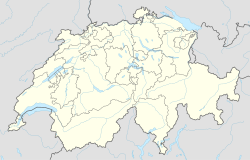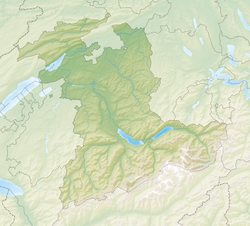Oberlangenegg
| Oberlangenegg | ||
|---|---|---|
|
||
| Coordinates: 46°47′N 7°43′E / 46.783°N 7.717°ECoordinates: 46°47′N 7°43′E / 46.783°N 7.717°E | ||
| Country | Switzerland | |
| Canton | Bern | |
| District | Thun | |
| Government | ||
| • Mayor | Ueli Jaberg | |
| Area | ||
| • Total | 9.12 km2 (3.52 sq mi) | |
| Elevation | 920 m (3,020 ft) | |
| Population (Dec 2015) | ||
| • Total | 474 | |
| • Density | 52/km2 (130/sq mi) | |
| Postal code | 3616 | |
| SFOS number | 0935 | |
| Surrounded by | Eriz, Horrenbach-Buchen, Röthenbach im Emmental, Teuffenthal, Unterlangenegg, Wachseldorn | |
| Website |
www SFSO statistics |
|
Oberlangenegg is a municipality in the administrative district of Thun in the canton of Bern in Switzerland.
Oberlangenegg is first mentioned in 1308 as Langonegga.
The oldest trace of a settlement in the area is a Bronze Age dagger which was discovered in the Lindenmoos. For most of its history Oberlangenegg and Unterlangenegg were combined into a single municipality and Oberlangenegg was the sparsely populated, heavily wooded part. The village of Schwarzenegg, located on the border with Unterlangenegg, was more densely populated and was an economic and religious center of the Zulg valley. Schwarzenegg was located on the Steffisburg-Oberemmental road and in 1693 a large parish church was built to help curb the growing popularity of the Anabaptist faith in the region. Today the municipality is still mostly agrarian and rural with over half of the local jobs in agriculture. In 2005 a wood working factory opened in the village and provides some manufacturing jobs.
Oberlangenegg has an area of 9.12 km2 (3.52 sq mi). As of the 2006 survey, a total of 4.15 km2 (1.60 sq mi) or 45.5% is used for agricultural purposes, while 4.47 km2 (1.73 sq mi) or 49.0% is forested. Of rest of the municipality 0.42 km2 (0.16 sq mi) or 4.6% is settled (buildings or roads), 0.03 km2 (7.4 acres) or 0.3% is either rivers or lakes and 0.04 km2 (9.9 acres) or 0.4% is unproductive land.
From the same survey, housing and buildings made up 2.4% and transportation infrastructure made up 1.5%. All of the forested land area is covered with heavy forests. Of the agricultural land, 7.8% is used for growing crops and 37.4% is pasturage. All the water in the municipality is flowing water.
The municipality is located in the Zulg river valley on the western slope and foot hills of the Honegg mountain. It consists of two clusters of settlements, the outer with Stalden and part of the village of Schwarzenegg (shared with Unterlangenegg) and the inner with Kreuzweg, Aettenbühl and Süderen-Linden.
...
Wikipedia




